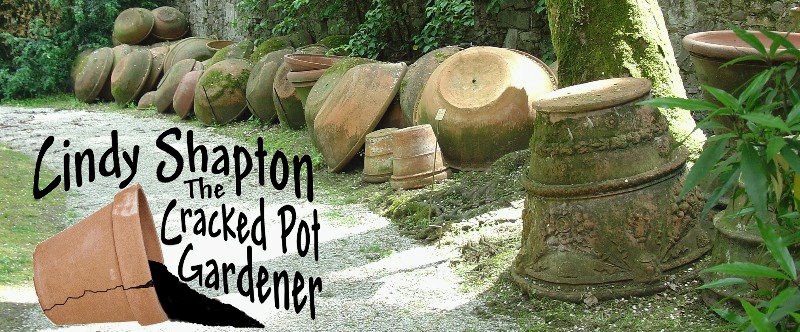 ted falling late in the day covering the earth in a fluffy white blanket. The reflection of the nearly full moon woke me up during the night and I could scarcely wait until dawn to get outside and have a look at the garden.
ted falling late in the day covering the earth in a fluffy white blanket. The reflection of the nearly full moon woke me up during the night and I could scarcely wait until dawn to get outside and have a look at the garden.Annie and I headed outdoors early and the first thing to hit us was the silence. Snow makes everything so quiet. The silence was soon broken with a horrible crunching racket as my neighbor headed out the driveway to work. It was then I realized there was a layer of ice just under the snow.
Dog and cracked pot with camera in hand slowly made the rounds admiring the beauty of white crested magnolia leaves and ice encrusted berries. Snow makes everything clean and fresh, even the wheelbarrow full of old perennial cuttings pointing towards the fire pit with good intentions looked picturesque.

Hemlock branches were heavy laden and looked like a winter scene right out of “It’s a Wonderful Life”. Red and Yellow Twig Dogwoods seemed happy to show off their new winter coat that sparkled when the sun came up.

The plants on the living roof were tucked in and cozy under their blanket. Too bad they can’t settle in for a long winters nap. Although they face the north I believe the predicted 40 degree high would soon uncover them.

Birds sang happily as they darted to and fro snatching a quick sunflower seed from the feeder then dashing it against a nearby branch. The cardinals really showed out against the white background.
There is nothing like the beauty of a garden in winter especially with the addition of a little snow. Annie kept licking the snow like she had never seen it before. Being a transplant from the north I sometimes forget how wonderful a little snow can be. A “mini winter” now and then can be a good thing…a time to slow down, reflect and be ever so grateful when the sun comes out it melts away!






 I decided to make grape jelly this year so I harvested a couple of huge baskets and got to work. After I washed the huge clusters I laid them out on towels to dry.
I decided to make grape jelly this year so I harvested a couple of huge baskets and got to work. After I washed the huge clusters I laid them out on towels to dry. When they softened, I took them off the heat and put them in a stainless steel, heavy duty colander that nested in another stainless steel stock pot to catch all the juice. I mashed (pressed) the poor things until I had all the juice out and nothing but pulp left in the colander. I feed the skins and seeds to the compost pile…I wonder how many concord grapes will be coming up in the spring?
When they softened, I took them off the heat and put them in a stainless steel, heavy duty colander that nested in another stainless steel stock pot to catch all the juice. I mashed (pressed) the poor things until I had all the juice out and nothing but pulp left in the colander. I feed the skins and seeds to the compost pile…I wonder how many concord grapes will be coming up in the spring? As you can see they came out “pretty as a picture” and a real treat at the breakfast table!
As you can see they came out “pretty as a picture” and a real treat at the breakfast table!





















